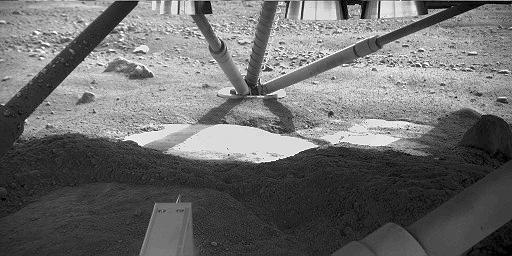Martian Ice (APOD 02 Jun 2008)
-
Sputnick
- Science Officer
- Posts: 458
- Joined: Thu Apr 10, 2008 7:18 pm
- AKA: Sputnick
- Location: Peterborough, Ontario, Canada
If the white stuff is rock the depressions will without question be 'potholes' common on earth - carved by water current using a small, hard stone or stones to grind the depression. If the white stuff is rock that means Phoenix landed on an extinct riverbed or lakeshore. Has the white stuff's composition been determined yet?
If man were made to fly he wouldn't need alcohol .. lots and lots and lots of alcohol to get through the furors while maintaining the fervors.
- iamlucky13
- Commander
- Posts: 515
- Joined: Thu May 25, 2006 7:28 pm
- Location: Seattle, WA
Indeed, the Phoenix team has stated that there was a slight horizontal motion at the time of touchdown and the lander "slid" a few inches, and the engines shut down a few feet above the ground to reduce the amount of debris kicked up to where it could land on the deck. The legs were designed to absorb the shock of hitting the ground at a few feet/second.Bad Buoys wrote:And there seems to have been slight horizontal movement of the craft at touchdown. In the far blast exposure there seems to be a very small amount of soil disturbed by the pad and rolling down ending atop all else. So the engines must have been shut down just prior to touchdown.
And while two thrusters appear flared, the nearest seems to be in some degree of focus.
I'm undecided if the 3rd thruster didn't flare as much, the soil consistency was slightly different (perhaps it was aligned over the edge of a polygonal trough), or the arm is too far underneath the craft to see a similar bare area. Perhaps "Snow Queen" is the third bare patch? I haven't taken a thorough look over the images for a couple days to get a sense of the position of these features.
"Any man whose errors take ten years to correct is quite a man." ~J. Robert Oppenheimer (speaking about Albert Einstein)
Pete, that can not be excluded. Note that the objects on the strut are lighter than the surrounding soil, in the shade. (125,90) has a pixel value of 122, the soil just below has values of 50 to 60. If any dirt, it must be white dirt.iampete wrote:Actually, I was thinking more along the lines of clumps of dust/dirt, rather than pebbles.
The melted water droplets must have a Martian origin, since hydrazine produces no water vapour. On Phoenix there is no oxygen on board to oxydize the hydrazine. It is not necessary.iampete wrote:is it credible to think that in the final few deciseconds prior to thruster shutdown, there exists a swirl of dust/soil particles and melted water droplets under the lander?
When water freezes on a surface, there are two forms of apparition:iampete wrote:This re-freezing would not be extremely quick, since even after thruster shutdown, the radiative heat from the thrusters themselves would take some time to dissipate.
- Slow freezing produces transparent ice.
Quick freezing, as when sprinkling water droplets on a tube, just being dipped in liquid nitrogen (77 K), produces white ice.
Regards,
Henk
21 cm: the universal wavelength of hydrogen
Henk
21 cm: the universal wavelength of hydrogen
Okay, it seems that the strut was splashed with some of the water melted from "Ice Queen"
when landing. It appears to have frozen as it splattered onto the strut and frozen as shown in

I wonder, after the recent ice sublimation in the scoop hole, if this strut ice had also sublimated.
And isn't sublimation better than distillation in concentrating solutes?
What kind of instruments are available on this lander? Any microscopes?
when landing. It appears to have frozen as it splattered onto the strut and frozen as shown in

I wonder, after the recent ice sublimation in the scoop hole, if this strut ice had also sublimated.
And isn't sublimation better than distillation in concentrating solutes?
What kind of instruments are available on this lander? Any microscopes?
- iamlucky13
- Commander
- Posts: 515
- Joined: Thu May 25, 2006 7:28 pm
- Location: Seattle, WA
Wow...I didn't hear this before. Is the splashing confirmed by NASA anywhere?
The is a camera on the robotic arm. It is not a microscope, but it can focuse pretty close. However, it can not operate underneath the lander, or at least the operators will not risk moving it around under the lander.
The is a camera on the robotic arm. It is not a microscope, but it can focuse pretty close. However, it can not operate underneath the lander, or at least the operators will not risk moving it around under the lander.
"Any man whose errors take ten years to correct is quite a man." ~J. Robert Oppenheimer (speaking about Albert Einstein)
Okay, so I've come to believe water[ice currently] is much more prevalent on Mars than ever thought. Not only do we land atop it, but the July 8 APOD looks to me to have a floor of water vs the lava speculated. There is APOD discussion (you'll have to skim over all the posts concerning optical coloration); but I can't, having been a commercial crab fisherman in the Aleutians, escape the similarity those cracks in the smooth valley floor have in common with Arctic ice leads which open in the Spring and Summer only to refreeze in the Fall.
I wish we could do some experiments with water and see how fast it sublimates in shade versus full sun at the poles and equator. And additionally how much of the reflective, insulating soil is necessary to eliminate the sublimation.
Mars has become a much more interesting planet than originally envisioned.
I wish we could do some experiments with water and see how fast it sublimates in shade versus full sun at the poles and equator. And additionally how much of the reflective, insulating soil is necessary to eliminate the sublimation.
Mars has become a much more interesting planet than originally envisioned.
